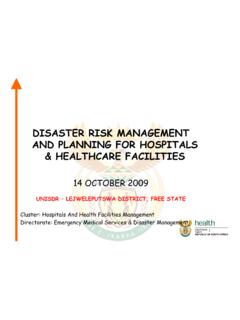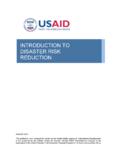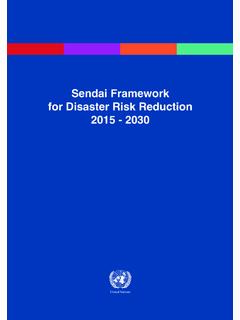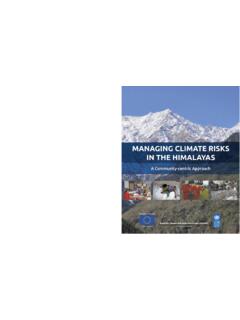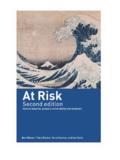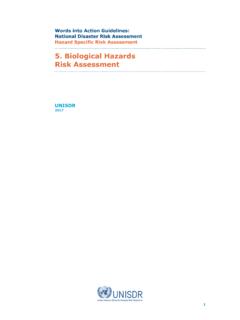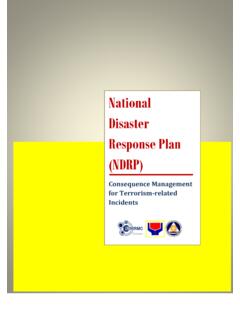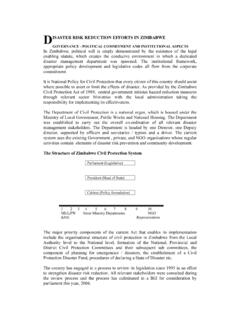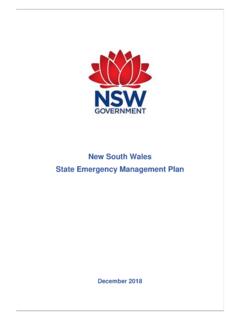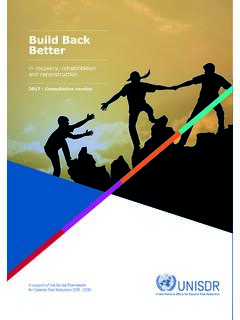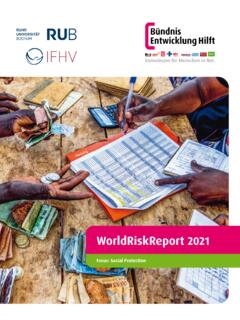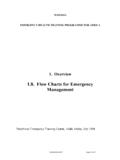Transcription of Disaster Preparedness Training Programme
1 Disaster Preparedness Training Programme Participant resource & learning moduleInternational Federation of Red Cross and Red Crescent Societies June 2000 2/20 Disaster Preparedness Training Programme International Federation of Red Cross and Red Crescent Societies Table of Contents BACKGROUND AND USES 3 THE NINE Disaster Preparedness MODULES AND TRAINER'S NOTES 4 AIM AND AUDIENCE 5 MAIN POINTS 5 1. OVERVIEW OF Disaster Preparedness 5 Disaster Preparedness AND THE RED CROSS AND RED CRESCENT 5 AIMS AND OBJECTIVES OF Disaster 6 2. HAZARDS, DISASTERS AND VULNERABILITY 6 3. Disaster CLASSIFICATIONS 7 HAZARDS CAUSING 8 SPEED OF 8 ACTS OF NATURE OR ACTS OF 9 4. Disaster Preparedness MEASURES 9 HAZARD, RISK AND VULNERABILITY 10 RESPONSE MECHANISMS AND 10 Preparedness 11 11 INFORMATION 12 EARLY WARNING 13 RESOURCE 14 PUBLIC EDUCATION, Training AND 14 5.
2 COMMUNITY-BASED Disaster Preparedness 15 6. INTEGRATING Disaster Preparedness WITH OTHER NS ACTIVITIES 16 ANNEX 1: Preparedness AND PLANNING FOR national SOCIETIES 17 ANNEX 2: SAMPLE national SOCIETY Disaster Preparedness PLAN20 June 2000 3/20 Disaster Preparedness Training Programme International Federation of Red Cross and Red Crescent Societies Background and uses This module is one of nine modules that have been prepared by INTERWORKS for the International Federation of Red Cross and Red Crescent Societies Disaster Preparedness office in Geneva.
3 This module can be used as for independent study, as a reference guide on the subject, and to provide participants at a workshop Training event on this topic. It is intended to accompany the trainer's notes on this topic. Their intended use is global, and they are written for generalists, planners and professionals with Disaster Preparedness and/or emergency response responsibilities both within the Federation and in the national Societies. Non-governmental organisations interested in Disaster Preparedness and Preparedness planning, government emergency commissions, local Disaster committees and civil defence Training units may also find these modules useful. This material can be used as: A general reference material on Disaster Preparedness Training and workshop modules and trainer's guides An orientation to Disaster Preparedness for Delegates and NS officers A guide for assessing or planning Disaster Preparedness capabilities All nine of these modules are revised and updated versions of modules that were initially developed for the Central Asia IFRC Disaster Preparedness Regional Delegation DP project in 1998.
4 This project resulted from recommendations and Training needs expressed by Central Asian national Society and Emergency Commission staff attending the IFRC sponsored regional Disaster Preparedness conference held in Tashkent, Uzbekistan from June 24-26, 1996. The overall aim of the Central Asia DP Training project was to support the national Societies in further developing their own structures for Preparedness in conjunction with those of the Emergency Committees, Ministries and Civil Defence organisations in each of the five countries in the region. To date, Disaster Preparedness in the region has been typified by highly response oriented, well maintained and trained Civil Defence organisations; and largely unprepared, and untrained local populations and non-governmental organisations. Disaster management has traditionally consisted of Preparedness for efficient and centralised emergency response, not the development of community-based or localised Preparedness capacity.
5 The Central Asia DP Training Programme was one attempt to change this emphasis and was proposed as a starting point from which revisions, and modifications for use on a country-by-country basis were expected and welcomed. This material is based on a multi-hazard approach, and is typically applicable to Preparedness in all of the hazard situations represented. However, the specific country context of the readers and trainees will necessitate a focus on the hazard types that are most applicable to their situation. While the modules and accompanying trainer s notes are written for use at national level workshops, individuals with Training responsibilities are encouraged to use and adapt the material for use at more local regions and towns. June 2000 4/20 Disaster Preparedness Training Programme International Federation of Red Cross and Red Crescent Societies The nine Disaster Preparedness modules and trainer's notes Introduction to Disaster Preparedness Preparedness Planning Risk Reduction Increasing Community Disaster Awareness Disaster Emergency Needs Assessment Disaster Programme Information and Reporting Improving Coordination Improving Basic Training Skills Project Planning Acknowledgements These nine modules and their accompanying trainer's notes were prepared for the International Federation by INTERWORKS, a consulting group with Disaster management Training and consulting experience in over 60 countries worldwide.
6 Review and critique of these modules were provided by a team of Central Asian Disaster management specialists, the Disaster Preparedness officers of five Central Asia national Societies, the Federation Disaster Preparedness staff in Geneva and delegates in Central Asia, the Caribbean and East Africa. The following documents served as references for the compilation and writing of this particular module: 1. " Disaster Preparedness " in the IFRC Handbook for Delegates, 1997. 2. Strategy 2010, IFRC 1999. 3. People-Oriented-Planning at Work: Using POP to Improve UNHCR Programming, M. Anderson for UNHCR, 1994. 4. "Report on national and Local Capabilities for Early Warning," Convenor of International Working Group and first authored by Mr. Andrew Maskrey for the IDNDR Secretariat, Geneva October 1997, p. F-8. June 2000 5/20 Disaster Preparedness Training Programme International Federation of Red Cross and Red Crescent Societies Introduction to Disaster Preparedness Aim and audience This module provides a common starting point for understanding and discussing disasters, Disaster management , and Disaster Preparedness as part of a national Society's mission, and discusses the potential scope of Disaster Preparedness measures.
7 This module is appropriate for anyone who has general responsibilities for Disaster management and Programme implementation. Non-technical personnel interested in acquiring a better understanding of Disaster Preparedness and the strategies and measures that may be implemented as part of a Preparedness plan can also benefit from reading this module. Main points how Disaster Preparedness fits into the work of the International Federation and national Societies the overarching aims and objectives of Disaster Preparedness definitions of the terms hazards, disasters and vulnerability identification of different types of disasters the scope of Disaster Preparedness measures the concept of community-based Disaster 1. Overview of Disaster Preparedness Disaster Preparedness and the Red Cross and Red Crescent Movement The purpose of the International Red Cross and Red Crescent Movement, as embodied in its Constitution and the principle of humanity, is to prevent and alleviate human suffering wherever it may be found, to protect life and health and ensure respect for the human being.
8 Disaster Preparedness fits within this overarching purpose and has been identified in IFRC's Strategy 2010, as one of the "core areas" that national Societies should prioritise and integrate into their overall programming efforts. Many people and agencies take part in emergency response operations including local populations and community-based organisations, Civil Defence and national emergency structures, fire brigades, Red Crescent/Red Cross Societies, international agencies, NGOs and others. The International Federation and national Societies need to recognise that Disaster Preparedness , particularly in terms of post- Disaster response, is primarily a government responsibility but that the national Society, as an auxiliary of the public authorities, can also make an important contribution. Therefore, national Societies should June 2000 6/20 Disaster Preparedness Training Programme International Federation of Red Cross and Red Crescent Societies communicate and coordinate their plans with those of other government agencies and non-governmental organisations involved in Disaster Preparedness and response.
9 This will improve planning, reduce duplication of efforts, make plans more realistic and increase the overall effectiveness of NS Disaster Preparedness and response efforts. Aims and objectives of Disaster Preparedness Disaster Preparedness refers to measures taken to prepare for and reduce the effects of disasters. That is, to predict and where possible prevent them, mitigate their impact on vulnerable populations, and respond to and effectively cope with their consequences. Disaster Preparedness is best viewed from a broad perspective and is more appropriately conceived of as a goal, rather than as a specialised Programme or stage that immediately precedes Disaster response. Disaster Preparedness is a continuous and integrated process resulting from a wide range of activities and resources rather than from a distinct sectoral activity by itself. It requires the contributions of many different areas ranging from Training and logistics, to health care to institutional development.
10 Viewed from this broad perspective, Disaster Preparedness encompasses the following objectives: Increasing the efficiency, effectiveness and impact of Disaster emergency response mechanisms at the community, national and Federation level. This includes: the development and regular testing of warning systems (linked to forecasting systems) and plans for evacuation or other measures to be taken during a Disaster alert period to minimise potential loss of life and physical damage the education and Training of officials and the population at risk the Training of first-aid and emergency response teams the establishment of emergency response policies, standards, organisational arrangements and operational plans to be followed after a Disaster Strengthening community-based Disaster Preparedness through national Society programmes for the community or through direct support of the community's own activity. This could include educating, preparing and supporting local populations and communities in their everyday efforts to reduce risks and prepare their own local response mechanisms to address Disaster emergency situations.
